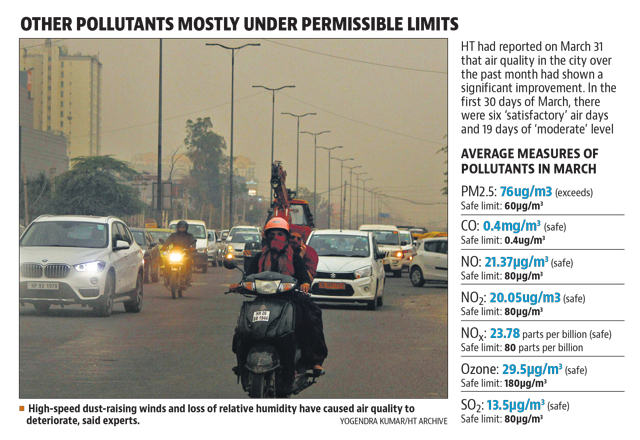Gurugram’s PM2.5 stayed in ‘danger zone’ in March
During the first 30 days of March, the city had six days of ‘satisfactory’ air quality, 19 days of ‘moderate’ air quality and four days of ‘poor’ air quality, as per the Central Pollution Control Board’s (CPCB) daily air quality index (AQI) bulletin.
According to the Haryana State Pollution Control Board’s (HSPCB) ambient air quality report for the city in March, the average daily level of PM2.5 stood at 76ug/m3, more than the safe limit of 60ug/m3 per day, as prescribed in the National Ambient Air Quality (NAAQ) standards.

However, it was lower than February’s daily average of 83.6ug/m3, indicating cleaner air in March.
HT had reported on March 31 that air quality in the city over the past month had shown a significant improvement due to cyclonic disturbances, rainfall and high atmospheric humidity. During the first 30 days of March, the city had six days of ‘satisfactory’ air quality, 19 days of ‘moderate’ air quality and four days of ‘poor’ air quality, as per the Central Pollution Control Board’s (CPCB) daily air quality index (AQI) bulletin.
“So, it is logical that there would have also been a reduction in the quantity of particulate pollutants during this time,” said Sachin Panwar, a city-based air quality consultant.
These figures are based on the data captured by the HSPSCB’s only working air quality monitor in the city, at Vikas Sadan.
The monitor also measured the quantity of other pollutants, namely carbon monoxide, ozone, nitrogen oxide and sulphur dioxide. All these were found, on an average, to be within their respective safe limits.
However, there were nine days in March when the level of carbon monoxide exceeded its safe measure, touching as much as 0.8mg/m3 on March 30, against the safe limit of 0.4ug/m3. The safe limit for carbon monoxide is 0.4ug/m3, as per the NAAQ standards.
There was also one day in March when the level of nitrogen oxides crossed the safety threshold, touching 192ug/m3. The safe limit for the same is 80ug/m3. The level of ozone, on the other hand, did not breach any of the notified safety standards, as per the data.

Kuldeep Singh, regional officer, HSPCB, said, “NOx, SOx and such pollutants are precursors to the formation of particulate matter, as they react in the air to form secondary aerosols. The fact that these pollutants were, on average, within their safe limits would have had an impact on the reduction of PM2.5 between February and March.”
Since March, however, high wind speeds and loss of relative humidity have caused air quality to deteriorate in Gurugram. The average daily PM2.5 concentration in April, so, far has been recorded at 109.5ug/m3. Singh said that this was due to the prevalence of dust raising winds that sweep up road dust and other crustal materials into the air.
More of these winds are likely to occur in the region as the summer progresses.

Stay updated with all the Breaking News and Latest News from Mumbai. Click here for comprehensive coverage of top Cities including Bengaluru, Delhi, Hyderabad, and more across India along with Stay informed on the latest happenings in World News.
Stay updated with all the Breaking News and Latest News from Mumbai. Click here for comprehensive coverage of top Cities including Bengaluru, Delhi, Hyderabad, and more across India along with Stay informed on the latest happenings in World News.





